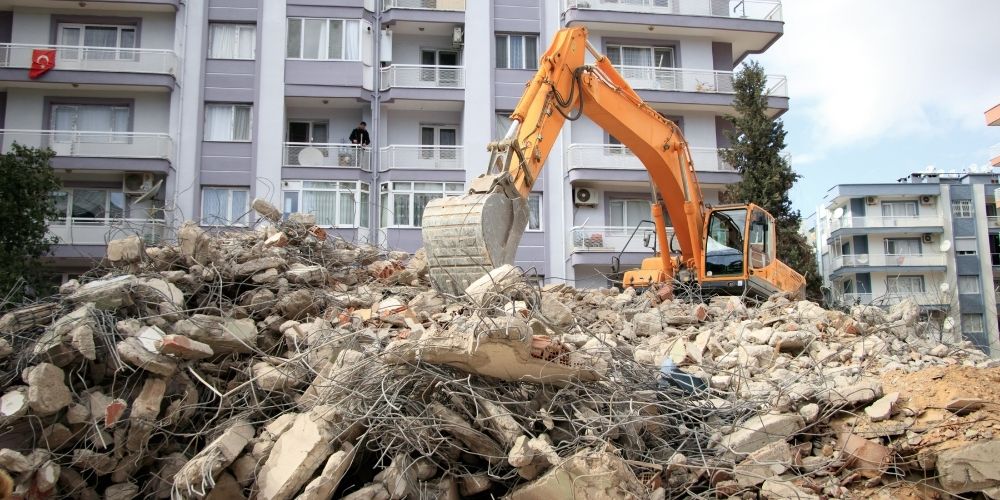If you’ve participated in any type of construction work recently, then you’ll be aware of the complaints about the skyrocketing cost of building materials.
A rise in building construction, along with supply issues that are blamed on the effects of the coronavirus epidemic - has sent prices for lumber, cement and other vital items soaring.
But the builders and their clients have no choice but to spend the money for the task completed.
“You should ensure that you have enough money for your needs, and it’s important to be prepared with a few extras in the event that something goes wrong , or for any cause,” says Joanna Spencer who is the director of the construction business R&J Construction Services.
One good result is that the more limited supplies have forced the industry to think more attentively on the way they use and dispose of their resources.
The construction industry creates an enormous amount of waste in fact, excavation, demolition, and construction made up a staggering 60% of United Kingdom’s total waste in the year 2018, according to the Department for Environment, Food and Rural Affairs.
In addition, a study from 2013 revealed the following: 13percent of the items sent to websites end up in landfills without ever being employed.
The majority of construction waste isn’t recyclable.
“When I talk to my members and they are making an effort to recycle trash in the right spot However, the products they use could be more environmentally friendly,” says Rico Wojtulewicz the head of planning and housing policy of the National Federation of Builders.
In addition, he says: “If you look at the way that local authorities recycle the majority of their waste is burned instead of recycling, which means the recycling industry requires an approach that is more strategic to reducing waste.”
It was the problem of waste that prompted Brittany Harris and Jade Cohen to come up with Qualis Flow, which sells an item designed to help manage construction materials.
As of now, according to Ms. Harris she believes that the construction industry has only unreliable, inconsistant data on the materials used at the construction site and the way they are employed or used.
Most firms depend on paper delivery notes and the collection of receipts for emails. The paper trail is manually input into a report-on-project tool, for instance, spreadsheet.
“Firstly the manual translation to data from one system can result in about 60% of the data being out of date or entering incorrectly. Therefore, the information we’ve got from these documents is almost ineffective,” she says.
“Secondly this industry is comprised of hundreds of massive contracting companies and thousands of smaller businesses who work together to complete these complicated projects.
Each company monitors and publishes information on their material consumption as well as the generation of waste in a variety of ways, in different methods.”
Although RFID and QR codes tags are used to track items but they’re not universal, so companies that rely on them is limited to the providers they can make use of.
Qflow, on the other hand permits all types of materials to be timed-in and out simply through a mobile app to take an image of the docket. This is then uploaded to the use of a web-based portal to display and download the information.
“It is able to be used instantly anyplace you own smartphones, and it can accommodate all kinds of construction projects, from commercial re-fits, to massive railroad infrastructure developments.”
Machine learning algorithms can then permit that data organized to find ways of reducing unnecessary waste and thereby making money, time and carbon footprint on the site.
The pressure is growing for building materials to be more effectively managed With Brexit along with the Covid pandemic creating a myriad of difficulties for suppliers.
“I believe that we’re the only major industry to remain open throughout lockdown. So all of our work was carried on. The only thing that didn’t go on was production of the material across the world,” says Mr Wojtulewicz.
“All material is dwindling and reducing supply which means that suddenly, it has caused a massive shortage of resources.”
Another company that aims to cut down on the amount of construction waste is Enviromate who operate an online marketplace for builders to purchase and sell surplus materials.
Co-founder Nigel Van Wassenhoven estimates that over the course of five years of operation the company has removed over 200,000 tons of materials from the waste stream with timber, bricks and roofing materials among the most popular items.
He states that, in the face of increasing costs, construction companies cannot afford to let their good materials go to waste.
Ms. Harris is, however, is looking for stronger regulation.
“A fantastic illustration of how regulation can play a significant role in changing behaviours is found as a case study in Health and Safety. There are some amazing statistics regarding the reduction in accidents and deaths between a decade ago and the present,” she says.
Similar improvements can be made with respect to waste she believes she could see if a new regulatory body were set in place that regulated how companies were able to report and manage the carbon footprints of their operations.
Waste management is now in the spotlight after an Environment Agency warning earlier this year that it will take measures against those who do not take care of waste responsibly.
Brian Berry, chief executive of the Federation of Master Builders, believes that the construction industry would benefit from more guidance.
“It is much more difficult for small builders to sort, recycle and store their materials on smaller, and particularly homes, properties, so we should provide extra assistance to builders in order to help them reduce their waste, reuse, and recycle,” he says.
“A clearly defined plan for what the industry of construction could make changes to cut down on it’s waste it generates will be beneficial for companies that thrive on certainty and a long-term plan.”


